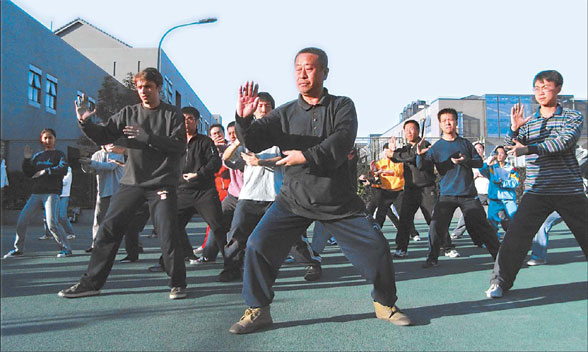
Beijing subway technician Ma Laiwang (center) has volunteered to teach students from Peking University and Chinese Academy of Sciences Chen Style taichi for over 20 years. The 54-year-old began learning kungfu at 6 and has been widely recognized as a kungfu master. Zhu Linyong
Wang Hexin, a sales manager at a medical store, is widely considered a veteran wushu practitioner in Beijing, trained in such kungfu styles as Mei Hua Quan, Da Cheng Quan, and Zhu Sha Zhang.
It is hard to imagine that back in the early 1970s when he was a small child, Wang was unable to stand after a botched medical treatment.
"My parents were deeply worried," recalls Wang, the only son in the rural family. Wang first began learning Chinese kungfu as therapy for his legs from some older villagers in the 1970s. After strenuous training, he managed to stand up, walk and even run, much to the delight of his parents.
"It is wushu that helped me gain self-confidence," says Wang who continued to learn from well-known kungfu masters such as Yu Yongnian in Beijing and Yang Yong in Wuhan, Hubei province.
Today, the 39-year-old spends most of his spare time, teaching teenagers in his home in Tongzhou district basic kungfu skills.
"Wushu is an indispensable part of my life," says Wang, a certified doctor of traditional Chinese medicine.
Wang is not alone in his passion for the centuries-old Chinese martial arts.
Liu Hongyi, 28, who works for a gifts company in Beijing, has invested most of his savings in learning and studying Chinese wushu over the past decade.
To get close to kungfu masters in the Chinese capital, he left his home city of Jixi in Heilongjiang province and attended many wushu training courses. In his small, rented apartment in Beijing, Liu has built an impressive stock of wushu books and DVDs. "Wushu is my only hobby," Liu says.
Official statistics show that China has at least 91 "kungfu counties and cities", each with over 100,000 practitioners of various wushu styles.
Wang and Liu are among the millions of people today who continue to practice wushu in and outside China, says Zhang Quanhai, a wushu practitioner and scholar with the Renmin University of China.
"Life changes and times change. But the ancient martial arts continue to be relevant," Zhang says.
Take taichi for example. In the 1950s, the Chinese government organized a group of kungfu masters and sports experts to simplify and standardize Chinese wushu styles.
As a result, a roster of simplified wushu forms (tao lu) featuring a series of postures and gestures were introduced to maintain good health, according to Zhang.